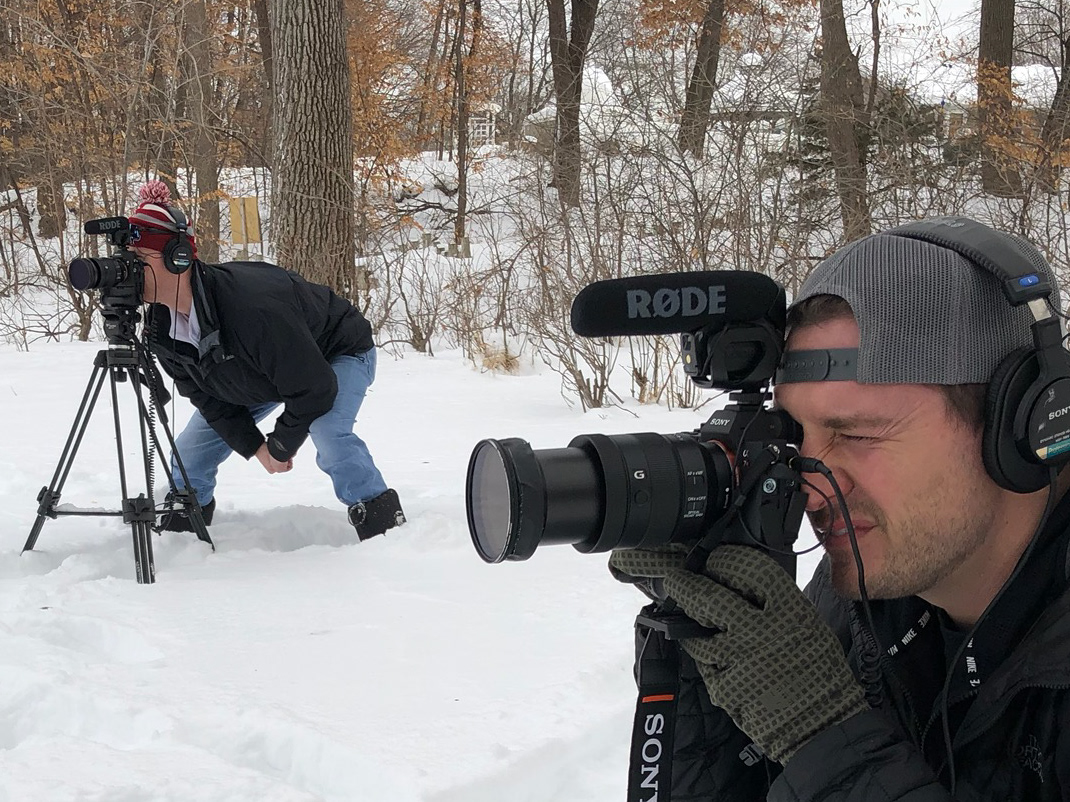We always want to look our best when we go into work, right? Then why stop when we’re at home on a video conference call? Even though we’ve been at this ‘looking good from the waste up’ game for several weeks now, we still see people doing things that make them look…not good. If you’re new to the video conference game, there are easy things we all can do to look better, aside from buying lights, a better web camera and a microphone (although these items aren’t as expensive as you think). Bottom line — if you use the stuff you’ve got and consider yourself a broadcaster — your video will look a lot better. In short, it’s one part MacGyver and one part Oprah. Here’s how...
1. Get your camera at eye level
All you need is a cardboard box or some stacked books. We all know what we look like in a picture if we’re looking down, and I can speak for myself here — it’s not pretty. So getting your computer or other device at your eye level or slightly above will make you look so much better. Trust us — no one wants an intimate relationship with your chin(s). Also, make sure you frame yourself so you don’t have too much head room (the space between the top of your head and the top of the screen) or too little where the top of your head is cut off.
2. Face your light
Your light source should come from your front, not your back. The easiest fix is to face a window. A picture window in your living room is usually the best spot. If that’s not possible, try setting a small table lamp near your computer. You might even need to hang a nice looking blanket over the window. If you were doing professional video work, ideally you’d want some sort of a three or four-point lighting scheme. But let’s be honest, you don’t need to look that professional, it’s a video conference call.
3. If the sound is bad, you’ve lost them
This is the same advice we give to our clients who do Vlogging or produce their own YouTube videos. While we want the picture to look great, if the sound stinks then don’t bother showering. Just put on your favorite adult-sized pajama onesie you bought one late night while crushing a box of Cheez-Its because it won’t matter what you look like. It always starts with the sound. If your computer mic is not up to the task, there’s a simple fix. Use headphones with a built in microphone, similar to the one you would use for your smartphone. You could also buy a cheap lav microphone for roughly $25 that plugs into the computer and clips onto your shirt. It makes the sound so much crisper. But make sure you’ve got a long enough cord, and don’t let the cord dangle in front of your shirt. Have some self-respect for crying out load. String it underneath. It looks cleaner and won’t get in the way.
4. Give some space behind you
This isn't always possible, but your shot looks so much better if you give some depth behind it. So instead of standing or sitting right in front of a wall, try to separate yourself from your background. The more space you can create typically the better you look. But a few feet from you and your background maybe all you need. This technique brings more depth to your shot and really takes the focus away from your surroundings and puts it squarely where it belongs - on you, which is the most important.
All you need is a cardboard box or some stacked books. We all know what we look like in a picture if we’re looking down, and I can speak for myself here — it’s not pretty. So getting your computer or other device at your eye level or slightly above will make you look so much better. Trust us — no one wants an intimate relationship with your chin(s). Also, make sure you frame yourself so you don’t have too much head room (the space between the top of your head and the top of the screen) or too little where the top of your head is cut off.
2. Face your light
Your light source should come from your front, not your back. The easiest fix is to face a window. A picture window in your living room is usually the best spot. If that’s not possible, try setting a small table lamp near your computer. You might even need to hang a nice looking blanket over the window. If you were doing professional video work, ideally you’d want some sort of a three or four-point lighting scheme. But let’s be honest, you don’t need to look that professional, it’s a video conference call.
3. If the sound is bad, you’ve lost them
This is the same advice we give to our clients who do Vlogging or produce their own YouTube videos. While we want the picture to look great, if the sound stinks then don’t bother showering. Just put on your favorite adult-sized pajama onesie you bought one late night while crushing a box of Cheez-Its because it won’t matter what you look like. It always starts with the sound. If your computer mic is not up to the task, there’s a simple fix. Use headphones with a built in microphone, similar to the one you would use for your smartphone. You could also buy a cheap lav microphone for roughly $25 that plugs into the computer and clips onto your shirt. It makes the sound so much crisper. But make sure you’ve got a long enough cord, and don’t let the cord dangle in front of your shirt. Have some self-respect for crying out load. String it underneath. It looks cleaner and won’t get in the way.
4. Give some space behind you
This isn't always possible, but your shot looks so much better if you give some depth behind it. So instead of standing or sitting right in front of a wall, try to separate yourself from your background. The more space you can create typically the better you look. But a few feet from you and your background maybe all you need. This technique brings more depth to your shot and really takes the focus away from your surroundings and puts it squarely where it belongs - on you, which is the most important.
5. Look into the camera
Don’t ignore the camera. It sounds obvious but we’ve been on video calls lately where people seemed afraid of looking at the camera, as if their souls would die a little bit each time they did. You don’t have to be laser focused on it, but it would be nice if you looked at it once and a while, especially if you’re talking. It’s the quickest way to make a connection. Remember, think like a broadcaster. The pros treat that camera like it’s a person because they know behind it there’s someone watching who is one.
Conclusion:
So there you have it. Some easy tips from the perspective of a video production team. This stuff isn’t rocket science, but we’ve noticed too often recently that some folks understandably aren’t used to being on camera. When in doubt, watch how the anchors, reporters and talk show hosts are doing it on television these days from their homes. Perhaps better yet, act like a broadcast photographer who may have helped set up those shots. It comes down to framing and capturing yourself as they would. Because the pros are in the same, sometimes surreal-feeling boat. Okay, back to buying another family-size box of Cheez-Its.
Don’t ignore the camera. It sounds obvious but we’ve been on video calls lately where people seemed afraid of looking at the camera, as if their souls would die a little bit each time they did. You don’t have to be laser focused on it, but it would be nice if you looked at it once and a while, especially if you’re talking. It’s the quickest way to make a connection. Remember, think like a broadcaster. The pros treat that camera like it’s a person because they know behind it there’s someone watching who is one.
Conclusion:
So there you have it. Some easy tips from the perspective of a video production team. This stuff isn’t rocket science, but we’ve noticed too often recently that some folks understandably aren’t used to being on camera. When in doubt, watch how the anchors, reporters and talk show hosts are doing it on television these days from their homes. Perhaps better yet, act like a broadcast photographer who may have helped set up those shots. It comes down to framing and capturing yourself as they would. Because the pros are in the same, sometimes surreal-feeling boat. Okay, back to buying another family-size box of Cheez-Its.










